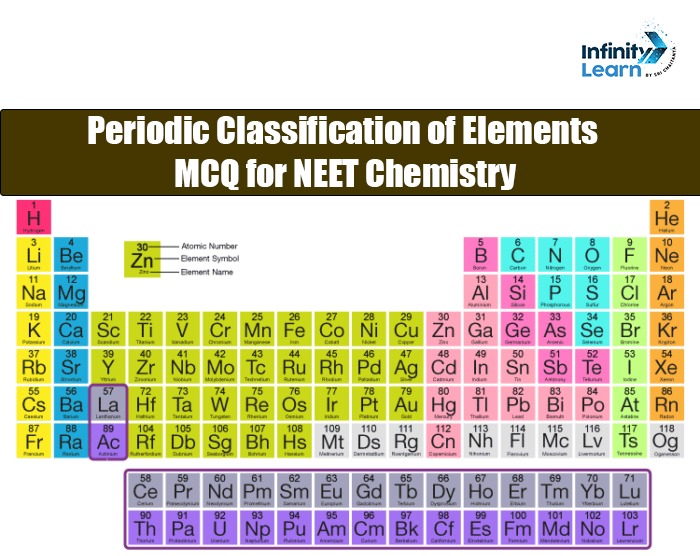Table of Contents
Periodic Classification of Elements MCQs: The Periodic Classification of Elements is a fundamental topic for NEET preparation, essential for understanding the arrangement and properties of elements. This classification organizes elements into groups and periods based on their atomic number, electron configurations, and recurring chemical properties. Knowing the periodic table helps NEET aspirants predict element behavior, understand trends like electronegativity and atomic size, and solve related questions efficiently. Mastery of this topic is crucial for scoring well in the Chemistry section of NEET, making it a key area of focus for students aiming to excel in the exam.

Periodic Classification of Elements
Periodic Classification of Elements is a important chapter in the Class 11 Chemistry syllabus and plays a major role in NEET exam preparation. This chapter provides a comprehensive understanding of how elements are systematically arranged in the periodic table based on their atomic number, electron configurations, and chemical properties. The knowledge gained from this chapter is essential for solving a wide range of NEET MCQs, as it helps students predict element behavior, understand periodic trends, and identify relationships between different elements.
Our experts have meticulously prepared NEET MCQs based on this chapter, covering every important topic as per the NEET syllabus. These topics include the modern periodic table, periodic trends such as atomic radius, ionization energy, electronegativity, and chemical reactivity. Understanding these concepts is vital for students to excel in the Chemistry section of the NEET exam, as questions related to the periodic classification often test a student’s ability to apply these principles in problem-solving. By mastering this Periodic Classification of Elements MCQs, students can significantly improve their performance in NEET, making it a cornerstone of their exam preparation.
Periodic Classification of Elements MCQs for NEET
1. Which of the following elements has the highest electronegativity?
a) Lithium
b) Fluorine
c) Carbon
d) Oxygen
Answer: b) Fluorine
2. The element with atomic number 17 belongs to which period and group of the periodic table?
a) Period 3, Group 17
b) Period 2, Group 16
c) Period 3, Group 16
d) Period 2, Group 17
Answer: a) Period 3, Group 17
3. Which of the following trends increases as you move from left to right across a period?
a) Atomic radius
b) Ionization energy
c) Metallic character
d) Electron affinity
Answer: b) Ionization energy
4. Which of the following elements is likely to form an anion with a charge of -2?
a) Magnesium
b) Sulfur
c) Sodium
d) Potassium
Answer: b) Sulfur
5. The first ionization energy of elements generally decreases down a group due to:
a) Increase in atomic radius
b) Increase in nuclear charge
c) Decrease in shielding effect
d) Increase in electron affinity
Answer: a) Increase in atomic radius
6. Which group of elements is known for having a complete valence shell?
a) Alkali metals
b) Alkaline earth metals
c) Halogens
d) Noble gases
Answer: d) Noble gases
7. The atomic radius of elements decreases across a period because:
a) Nuclear charge decreases
b) Shielding effect increases
c) Electrons are added to the same energy level
d) Electrons are added to higher energy levels
Answer: c) Electrons are added to the same energy level
9. Which period of the periodic table contains the transition metals?
a) Period 2
b) Period 3
c) Period 4
d) Period 5
Answer: c) Period 4
10. The element with atomic number 20 is classified as a:
a) Alkali metal
b) Transition metal
c) Halogen
d) Alkaline earth metal
Answer: d) Alkaline earth metal
11. Which of the following elements would be expected to have the smallest atomic radius?
a) Nitrogen
b) Phosphorus
c) Arsenic
d) Bismuth
Answer: a) Nitrogen
12. What is the common oxidation state of the elements in Group 16 of the periodic table?
a) +2
b) -2
c) +1
d) -1
Answer: b) -2
13. Which of the following is the most reactive non-metal?
a) Fluorine
b) Chlorine
c) Bromine
d) Iodine
Answer: a) Fluorine
14. The diagonal relationship is observed between which of the following pairs of elements?
a) Lithium and Magnesium
b) Sodium and Potassium
c) Carbon and Silicon
d) Nitrogen and Phosphorus
Answer: a) Lithium and Magnesium
15. Which element is placed in the d-block of the periodic table?
a) Calcium
b) Iron
c) Oxygen
d) Phosphorus
Answer: b) Iron
16. Which of the following properties decreases down the group in alkali metals?
a) Melting point
b) Atomic radius
c) Density
d) Reactivity
Answer: a) Melting point
17. The elements with atomic numbers 58 to 71 are collectively known as:
a) Actinides
b) Lanthanides
c) Transition elements
d) Metalloids
Answer: b) Lanthanides
19. The term “isoelectronic” refers to species having:
a) Same number of protons
b) Same number of electrons
c) Same number of neutrons
d) Same atomic radius
Answer: b) Same number of electrons
20. Which element is placed at the top of Group 14 in the periodic table?
a) Carbon
b) Silicon
c) Germanium
d) Tin
Answer: a) Carbon
Periodic Classification of Elements MCQs for NEET (High level)
1. If the atomic weight of Nitrogen (N) is 14 and that of Phosphorus (P) is 31, what would be the approximate atomic weight of Arsenic (As) according to Dobereiner’s triad rule?
a) 45
b) 35
c) 22.5
d) 27.5
Answer: d) 27.5
2. The law of octaves, proposed by Newlands, suggested that:
a) Properties of every second element were similar.
b) Properties repeated every seventh element.
c) Properties repeated every eighth element.
d) Properties were irregularly repeated.
Answer: c) Properties repeated every eighth element.
3. Which set of elements correctly follows the octet rule as per Newlands?
a) Li, Na, K
b) Mg, Ca, Sr
c) Cl, Br, I
d) O, S, Se
Answer: a) Li, Na, K
4. In Lothar Meyer’s curve, which element group occupies the descending portions of the curve?
a) Alkali metals
b) Halogens
c) Transition metals
d) Noble gases
Answer: b) Halogens
5. Identify the incorrect statement about Lothar Meyer’s classification:
a) Alkaline earth metals are present at the peaks.
b) Representative elements are in the middle of the curve.
c) Halogens occupy the descending portions.
d) The curve plots atomic volume against atomic weight.
Answer: a) Alkaline earth metals are present at the peaks.
6. According to Lothar Meyer’s curve, which of the following statements is correct?
a) Alkali metals occupy the minima.
b) Atomic volumes of elements increase uniformly across a period.
c) Elements with large atomic volumes occupy the peaks.
d) The curve does not apply to transition metals.
Answer: c) Elements with large atomic volumes occupy the peaks.
7. Elements at the peaks of Lothar Meyer’s curve are typically:
a) Halogens
b) Noble gases
c) Transition metals
d) Alkali metals
Answer: d) Alkali metals
8. Which of the following is incorrect about the modern Mendeleev’s periodic table?
a) It has seven periods and nine groups.
b) Elements are arranged by increasing atomic weight.
c) Isotopes are placed in the same position.
d) Each group has a different number of elements.
Answer: d) Each group has a different number of elements.
9. Mendeleev’s periodic table was primarily organized based on:
a) Atomic number
b) Atomic mass
c) Valency
d) Number of protons
Answer: b) Atomic mass
10. In Mendeleev’s periodic table, which group contains the maximum number of elements?
a) Group 1
b) Group 2
c) Group 3
d) Group 4
Answer: c) Group 3
11. Which was one of the major shortcomings of Mendeleev’s periodic table?
a) Position of noble gases was not justified.
b) Isotopes were placed together.
c) Lanthanides and actinides were grouped separately.
d) Hydrogen was placed in Group 7.
Answer: b) Isotopes were placed together.
13. Mendeleev left gaps in his periodic table for which of the following elements?
a) Silicon and Germanium
b) Gallium and Germanium
c) Molybdenum and Tungsten
d) Tellurium and Polonium
Answer: b) Gallium and Germanium
14. Which of the following pairs did not show an anomalous position in Mendeleev’s periodic table?
a) Cobalt and Nickel
b) Argon and Potassium
c) Tellurium and Iodine
d) Helium and Neon
Answer: d) Helium and Neon
15. Which of the following elements did Mendeleev predict before it was discovered?
a) Germanium
b) Aluminum
c) Calcium
d) Oxygen
Answer: a) Germanium
16. The position of which element was not justified in Mendeleev’s periodic table?
a) Hydrogen
b) Helium
c) Argon
d) Fluorine
Answer: a) Hydrogen
17. In Mendeleev’s periodic table, which group contains the halogens?
a) Group 17
b) Group 1
c) Group 2
d) Group 7
Answer: a) Group 17
18. Which of the following was not predicted by Mendeleev?
a) Eka-Silicon
b) Eka-Aluminium
c) Noble gases
d) Transition metals
Answer: c) Noble gases
19. According to Mendeleev’s periodic law, the properties of elements are a periodic function of their:
a) Atomic number
b) Atomic mass
c) Electron configuration
d) Valence electrons
Answer: b) Atomic mass
20. The modern periodic table resolves the anomalies in Mendeleev’s table by arranging elements according to:
a) Atomic weight
b) Atomic number
c) Valency
d) Electron affinity
Answer: b) Atomic number







